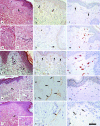Radiogenic lymphangiogenesis in the skin
- PMID: 17591978
- PMCID: PMC1941592
- DOI: 10.2353/ajpath.2007.060589
Radiogenic lymphangiogenesis in the skin
Abstract
The time course of microvascular changes in the environment of irradiated tumors was studied in a standardized human protocol. Eighty skin biopsies from 40 patients with previously treated primary breast cancer were taken from irradiated skin and corresponding contralateral unirradiated control areas 2 to 8 weeks, 11 to 14 months, or 17+ months after radiotherapy (skin equivalent dose 30 to 40 Gy). Twenty-two biopsies of 11 melanoma patients who had undergone lymph node dissection were used for unirradiated control. We found an increase of total podoplanin(+) lymphatic microvessel density resulting mainly from a duplication of the density of smallest lymphatic vessels (diameter <10 microm) in the samples taken 1 year after radiation. Our findings implicate radiogenic lymphangiogenesis during the 1st year after therapy. The numbers of CD68(+) and vascular endothelial growth factor-C(+) cells were highly elevated in irradiated skin in the samples taken 2 to 8 weeks after radiotherapy. Thus, our results indicate that vascular endothelial growth factor-C expression by invading macrophages could be a pathogenetic route of induction of radiogenic lymphangiogenesis.
Figures



Similar articles
-
Merkel cell carcinoma induces lymphatic microvessel formation.J Am Acad Dermatol. 2012 Aug;67(2):215-25. doi: 10.1016/j.jaad.2011.09.002. Epub 2011 Nov 3. J Am Acad Dermatol. 2012. PMID: 22050913
-
[Expression of vascular endothelial growth factors (VEGF)-A, -C and -D and their prognostic significance and relationship with angio- and lymphangiogenesis in gastric cancer].Zhonghua Zhong Liu Za Zhi. 2008 Nov;30(11):837-43. Zhonghua Zhong Liu Za Zhi. 2008. PMID: 19173829 Chinese.
-
Lymphangiogenesis and its relationship with lymphatic metastasis and prognosis in malignant melanoma.Anat Rec (Hoboken). 2008 Oct;291(10):1227-35. doi: 10.1002/ar.20736. Anat Rec (Hoboken). 2008. PMID: 18561194
-
Molecular control of lymphatic metastasis.Ann N Y Acad Sci. 2008;1131:225-34. doi: 10.1196/annals.1413.020. Ann N Y Acad Sci. 2008. PMID: 18519975 Review.
-
Tumor lymphangiogenesis and melanoma metastasis.J Cell Physiol. 2008 Aug;216(2):347-54. doi: 10.1002/jcp.21494. J Cell Physiol. 2008. PMID: 18481261 Review.
Cited by
-
Plasticity of airway lymphatics in development and disease.Adv Anat Embryol Cell Biol. 2014;214:41-54. doi: 10.1007/978-3-7091-1646-3_4. Adv Anat Embryol Cell Biol. 2014. PMID: 24276885 Free PMC article. Review.
-
Transgenic overexpression of interleukin-1β induces persistent lymphangiogenesis but not angiogenesis in mouse airways.Am J Pathol. 2013 Apr;182(4):1434-47. doi: 10.1016/j.ajpath.2012.12.003. Epub 2013 Feb 4. Am J Pathol. 2013. PMID: 23391392 Free PMC article.
-
Vascular endothelial growth factor-C enhances radiosensitivity of lymphatic endothelial cells.Angiogenesis. 2014 Apr;17(2):419-27. doi: 10.1007/s10456-013-9400-7. Epub 2013 Nov 8. Angiogenesis. 2014. PMID: 24201897 Free PMC article.
-
Radiation therapy attenuates lymphatic vessel repair by reducing VEGFR-3 signalling.Front Pharmacol. 2023 Apr 28;14:1152314. doi: 10.3389/fphar.2023.1152314. eCollection 2023. Front Pharmacol. 2023. PMID: 37188266 Free PMC article.
-
Acquired lymphangiectasis following surgery and radiotherapy of breast cancer.Indian J Dermatol. 2015 Jan-Feb;60(1):106. doi: 10.4103/0019-5154.147880. Indian J Dermatol. 2015. PMID: 25657438 Free PMC article.
References
-
- Archambeau JO, Ines A, Fajardo LF. Correlation of the dermal microvasculature morphology with the epidermal and the endothelial population changes produced by single X ray fractions of 1649, 2231 and 2619 rad in swine. Int J Radiat Oncol Biol Phys. 1985;11:1639–1646. - PubMed
-
- Takahashi S, Sugimoto M, Kotoura Y, Sasai K, Oka M, Yamamuro T. Long-term changes in the haversian systems following high-dose irradiation: an ultrastructural and quantitative histomorphological study. J Bone Joint Surg Am. 1994;76:722–738. - PubMed
-
- Tsai JH, Makonnen S, Feldman M, Sehgal CM, Maity A, Lee WM. Ionizing radiation inhibits tumor neovascularization by inducing ineffective angiogenesis. Cancer Biol Ther. 2005;4:1395–1400. - PubMed
-
- Fajardo LF. The pathology of ionizing radiation as defined by morphologic patterns. Acta Oncol. 2005;44:13–22. - PubMed
-
- Reinhold HS. The influence of radiation on blood vessels and circulation. Chapter IV. Structural changes in blood vessels. Curr Top Radiat Res Q. 1974;10:58–74. - PubMed
Publication types
MeSH terms
Substances
LinkOut - more resources
Full Text Sources
Medical

